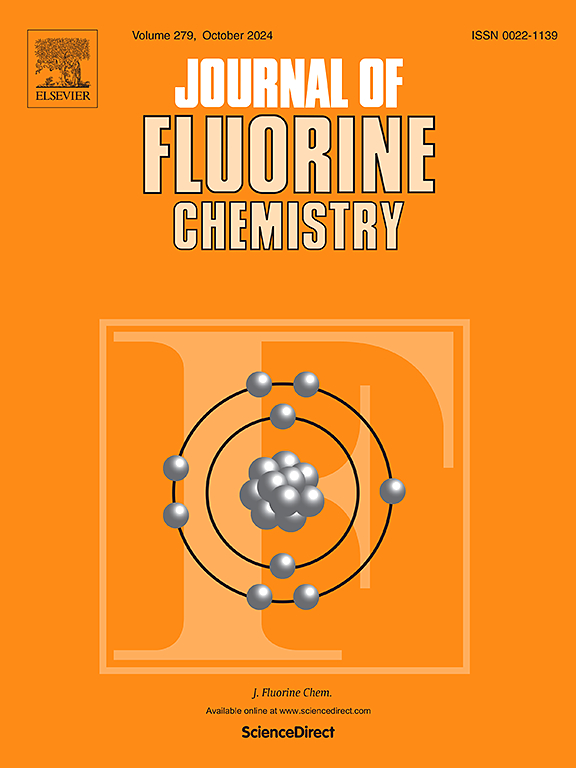无机氟化物的固态化学:从钨青铜型到功能化纳米氟化物:综述
IF 1.7
4区 化学
Q3 CHEMISTRY, INORGANIC & NUCLEAR
引用次数: 0
摘要
无机氟化物的固态化学在20世纪下半叶得到了极大的重视。它旨在确定结构网络与这些网络内相互作用产生的物理性质之间的关系。最重要的成果之一是在20世纪60年代发现了一系列与氧化钨青铜结构相似的AxMF3氟化物。其他主要基于Al、Ga和过渡金属的化合物,其结构来源于ReO3、六方钨青铜(HTB)、四方钨青铜(TTB)、缺陷焦绿石和钙钛矿,这是研究其磁性能的第一步。这种兴趣进一步扩展到各种性质,如锂离子电池的正极,紫外线吸收剂,多铁性元件。今天,固态无机氟化物作为纳米级的成分存在于许多先进技术中,包括锂电池或所有固态氟电池、微或纳米光子学、向上或向下转换荧光探针、固态激光器、非线性光学、核循环、超疏水涂层等。指出这些突出的性质大多与氟元素F2的特殊电子性质有关。本文的目的是回顾几十年来分子式为AxMF3的氟化物的固态化学性质,从它们在20世纪60年代被发现到最近在这些由ReO3、钙钛矿、缺陷焦绿石、六方和四方钨青铜类型衍生的相上研究的有趣的物理化学性质。本文章由计算机程序翻译,如有差异,请以英文原文为准。

Solid-state chemistry of inorganic fluorides: From tungsten-bronze types to functionalized nanofluorides: A review
Solid-state chemistry of inorganic fluorides has gained great importance in the second half of 20th century. It aims at identifying the relationships between the structural networks and the physical properties resulting from interactions within these networks. One of the most significant results was the discovery in the 1960s of series of AxMF3 fluorides with structures similar to those of tungsten oxide bronzes. The investigation of other compounds mainly based on Al, Ga and transition metals with structures derived from ReO3, hexagonal tungsten bronze (HTB), tetragonal tungsten bronzes (TTB), defect pyrochlore and perovskite was soon launched in relation, in a first step, to their magnetic properties. Such interest was further extended to various properties such as positive electrodes in Li-ion batteries, UV absorbers, multiferroic components. Today, solid-state inorganic fluorides are present at the nano-sized level as components in many advanced technologies, including Li batteries or all solid-state fluorine batteries, micro- or nano-photonics, up- or down-conversion fluorescent probes, solid-state lasers, nonlinear optics, nuclear cycle, superhydrophobic coatings, etc. It has been pointed out that most of these outstanding properties can be correlated to the exceptional electronic properties of elemental fluorine, F2.
The aim of this article is to review the solid-state chemistry of fluorides having the formula AxMF3 over several decades, from their discovery in the 1960s to the interesting physical-chemical properties more recently investigated on these phases that derive from the ReO3, perovskite, defect-pyrochlore, hexagonal- and tetragonal- tungsten bronze types.
求助全文
通过发布文献求助,成功后即可免费获取论文全文。
去求助
来源期刊

Journal of Fluorine Chemistry
化学-无机化学与核化学
CiteScore
3.80
自引率
10.50%
发文量
99
审稿时长
33 days
期刊介绍:
The Journal of Fluorine Chemistry contains reviews, original papers and short communications. The journal covers all aspects of pure and applied research on the chemistry as well as on the applications of fluorine, and of compounds or materials where fluorine exercises significant effects. This can include all chemistry research areas (inorganic, organic, organometallic, macromolecular and physical chemistry) but also includes papers on biological/biochemical related aspects of Fluorine chemistry as well as medicinal, agrochemical and pharmacological research. The Journal of Fluorine Chemistry also publishes environmental and industrial papers dealing with aspects of Fluorine chemistry on energy and material sciences. Preparative and physico-chemical investigations as well as theoretical, structural and mechanistic aspects are covered. The Journal, however, does not accept work of purely routine nature.
For reviews and special issues on particular topics of fluorine chemistry or from selected symposia, please contact the Regional Editors for further details.
 求助内容:
求助内容: 应助结果提醒方式:
应助结果提醒方式:


